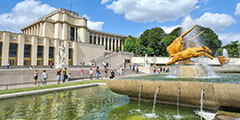During the 1937 International Exhibition, more than twenty pavilions representing various countries were built in the Trocadéro gardens. Among them, the Spanish pavilion, where Guernica was showed for the first time.
More than forty countries had their own pavilion during the 1937 International Exhibition, which was mentioned earlier when we spoke about the Peace Pavilion on the Trocadéro Square. The Spanish pavilion was located at the end of the Trocadéro gardens, left when facing the Eiffel Tower from the Trocadéro esplanade. In 1937, Spain was in the middle of a civil war between the Republicans and the Francoist forces, the latter being supported by the Nazi Germany and the Fascist Italy, whose pavilions were only some meters away. In order to decorate the pavilion, the Republican government called for help from Spanish artists living in Paris.
The pavilion opened shortly after the beginning of the Exhibition, on July 12th. Inside, visitors were able to admire The Mercury Fountain by Alexander Calder, as well as a large mural painting by Miró, The Reaper or Catalan Peasant in Revolt, showing a figure with a red beret, contemplating a starry sky. This work was in sharp contrast with the second monumental painting showed in the pavilion: Guernica, by Picasso. This huge painting on canvas was made in reaction to the bombing of the small town of Guernica, in the Basque Country, by the German and Italian air forces, on April 26th, 1937. Described by Nazis who visited the pavilion as „the dream of a mad man […] a mix of incomprehensible symbols and pieces of human beings, the whole thing looking like drawn by a four-year-old child“, this painting reveals violence, suffering, death and helplessness, in black and white, just like war photographs at the time. This emblematic work, surely Picasso’s most famous painting, is above all an outcry against war and its destructions, but can also be seen as a poignant call for peace.
Some years later, during the war, Picasso was visited by Nazi Ambassador Otto Abetz in his Parisian studio. The latter came upon a picture of Guernica, which had been sent to New York by the painter as soon as the Exhibition was over. He asked: „Did you make this?“ to which Picasso answered: „No, you did“.
In accordance with Picasso’s will, Guernica was not sent back to Spain before democracy was restored in this country after Franco’s death.






 7 minutes
7 minutes